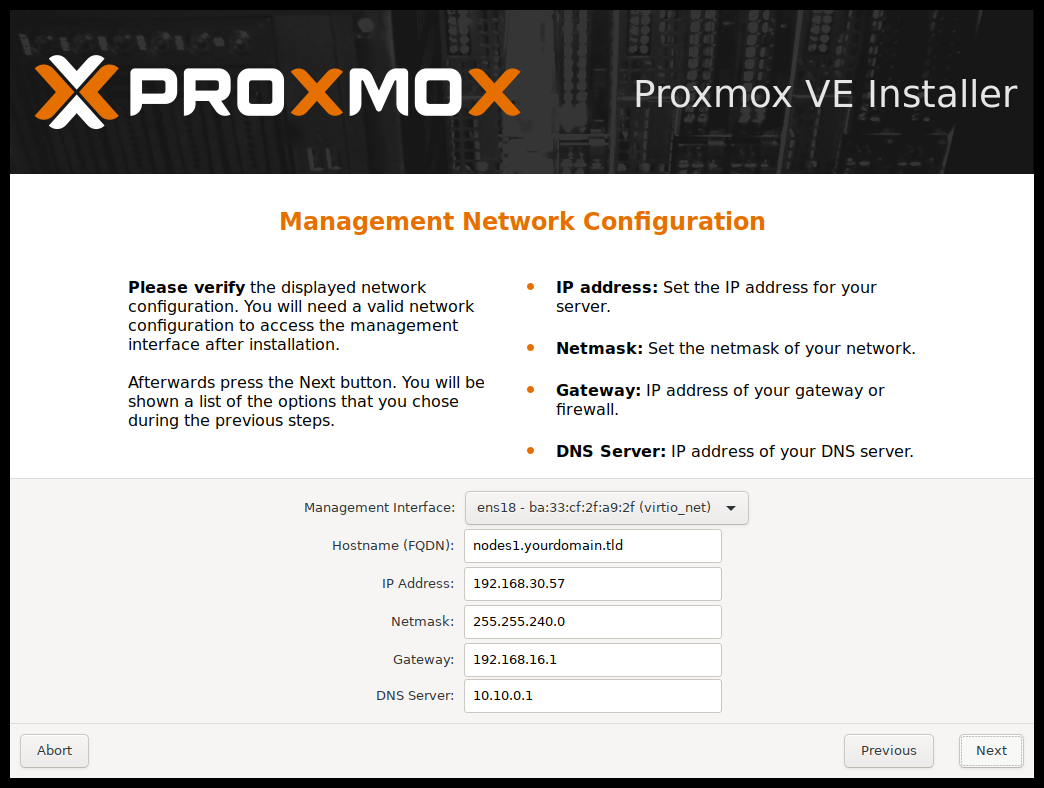Proxmox VE is based on Debian. This is why the install disk images (ISO files) provided by Proxmox include a complete Debian system as well as all necessary Proxmox VE packages.
|
|
See the support table in the FAQ for the relationship between Proxmox VE releases and Debian releases. |
The installer will guide you through the setup, allowing you to partition the local disk(s), apply basic system configurations (for example, timezone, language, network) and install all required packages. This process should not take more than a few minutes. Installing with the provided ISO is the recommended method for new and existing users.
Alternatively, Proxmox VE can be installed on top of an existing Debian system. This option is only recommended for advanced users because detailed knowledge about Proxmox VE is required.
System Requirements
We recommend using high quality server hardware, when running Proxmox VE in production. To further decrease the impact of a failed host, you can run Proxmox VE in a cluster with highly available (HA) virtual machines and containers.
Proxmox VE can use local storage (DAS), SAN, NAS, and distributed storage like Ceph RBD. For details see chapter storage.
Minimum Requirements, for Evaluation
These minimum requirements are for evaluation purposes only and should not be used in production.
-
CPU: 64bit (Intel 64 or AMD64)
-
Intel VT/AMD-V capable CPU/motherboard for KVM full virtualization support
-
RAM: 1 GB RAM, plus additional RAM needed for guests
-
Hard drive
-
One network card (NIC)
Recommended System Requirements
-
Intel 64 or AMD64 with Intel VT/AMD-V CPU flag.
-
Memory: Minimum 2 GB for the OS and Proxmox VE services, plus designated memory for guests. For Ceph and ZFS, additional memory is required; approximately 1GB of memory for every TB of used storage.
-
Fast and redundant storage, best results are achieved with SSDs.
-
OS storage: Use a hardware RAID with battery protected write cache (“BBU”) or non-RAID with ZFS (optional SSD for ZIL).
-
VM storage:
-
For local storage, use either a hardware RAID with battery backed write cache (BBU) or non-RAID for ZFS and Ceph. Neither ZFS nor Ceph are compatible with a hardware RAID controller.
-
Shared and distributed storage is possible.
-
SSDs with Power-Loss-Protection (PLP) are recommended for good performance. Using consumer SSDs is discouraged.
-
-
Redundant (Multi-)Gbit NICs, with additional NICs depending on the preferred storage technology and cluster setup.
-
For PCI(e) passthrough the CPU needs to support the VT-d/AMD-d flag.
Simple Performance Overview
To get an overview of the CPU and hard disk performance on an installed Proxmox VE system, run the included pveperf tool.
|
|
This is just a very quick and general benchmark. More detailed tests are recommended, especially regarding the I/O performance of your system. |
Supported Web Browsers for Accessing the Web Interface
To access the web-based user interface, we recommend using one of the following browsers:
-
Firefox, a release from the current year, or the latest Extended Support Release
-
Chrome, a release from the current year
-
Microsoft’s currently supported version of Edge
-
Safari, a release from the current year
When accessed from a mobile device, Proxmox VE will show a lightweight, touch-based interface.
Prepare Installation Media
Download the installer ISO image from: https://www.proxmox.com/en/downloads/proxmox-virtual-environment/iso
The Proxmox VE installation media is a hybrid ISO image. It works in two ways:
-
An ISO image file ready to burn to a CD or DVD.
-
A raw sector (IMG) image file ready to copy to a USB flash drive (USB stick).
Using a USB flash drive to install Proxmox VE is the recommended way because it is the faster option.
Prepare a USB Flash Drive as Installation Medium
The flash drive needs to have at least 1 GB of storage available.
|
|
Do not use UNetbootin. It does not work with the Proxmox VE installation image. |
|
|
Make sure that the USB flash drive is not mounted and does not contain any important data. |
Instructions for GNU/Linux
On Unix-like operating system use the dd command to copy the ISO image to the USB flash drive. First find the correct device name of the USB flash drive (see below). Then run the dd command.
# dd bs=1M conv=fdatasync if=./proxmox-ve_*.iso of=/dev/XYZ
|
|
Be sure to replace /dev/XYZ with the correct device name and adapt the input filename (if) path. |
|
|
Be very careful, and do not overwrite the wrong disk! |
Find the Correct USB Device Name
There are two ways to find out the name of the USB flash drive. The first one is to compare the last lines of the dmesg command output before and after plugging in the flash drive. The second way is to compare the output of the lsblk command. Open a terminal and run:
# lsblk
Then plug in your USB flash drive and run the command again:
# lsblk
A new device will appear. This is the one you want to use. To be on the extra safe side check if the reported size matches your USB flash drive.
Instructions for macOS
Open the terminal (query Terminal in Spotlight).
Convert the .iso file to .dmg format using the convert option of hdiutil, for example:
# hdiutil convert proxmox-ve_*.iso -format UDRW -o proxmox-ve_*.dmg
|
|
macOS tends to automatically add .dmg to the output file name. |
To get the current list of devices run the command:
# diskutil list
Now insert the USB flash drive and run this command again to determine which device node has been assigned to it. (e.g., /dev/diskX).
# diskutil list # diskutil unmountDisk /dev/diskX
|
|
replace X with the disk number from the last command. |
# sudo dd if=proxmox-ve_*.dmg bs=1M of=/dev/rdiskX
|
|
rdiskX, instead of diskX, in the last command is intended. It will increase the write speed. |
Instructions for Windows
Using Etcher
Etcher works out of the box. Download Etcher from https://etcher.io. It will guide you through the process of selecting the ISO and your USB flash drive.
Using Rufus
Rufus is a more lightweight alternative, but you need to use the DD mode to make it work. Download Rufus from https://rufus.ie/. Either install it or use the portable version. Select the destination drive and the Proxmox VE ISO file.
|
|
Once you Start you have to click No on the dialog asking to download a different version of GRUB. In the next dialog select the DD mode. |
Using the Proxmox VE Installer
The installer ISO image includes the following:
-
Complete operating system (Debian Linux, 64-bit)
-
The Proxmox VE installer, which partitions the local disk(s) with ext4, XFS, BTRFS (technology preview), or ZFS and installs the operating system
-
Proxmox VE Linux kernel with KVM and LXC support
-
Complete toolset for administering virtual machines, containers, the host system, clusters and all necessary resources
-
Web-based management interface
|
|
All existing data on the selected drives will be removed during the installation process. The installer does not add boot menu entries for other operating systems. |
Please insert the prepared installation media (for example, USB flash drive or CD-ROM) and boot from it.
|
|
Make sure that booting from the installation medium (for example, USB) is enabled in your server’s firmware settings. Secure boot needs to be disabled when booting an installer prior to Proxmox VE version 8.1. |
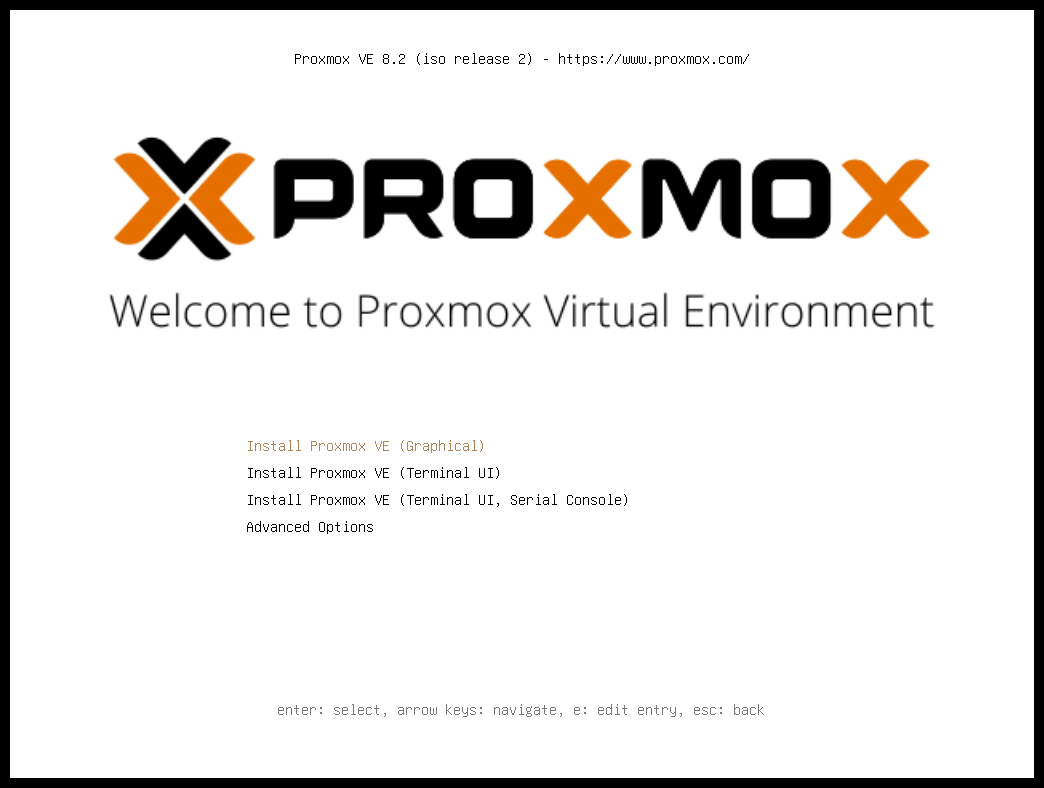
After choosing the correct entry (for example, Boot from USB) the Proxmox VE menu will be displayed, and one of the following options can be selected:
- Install Proxmox VE (Graphical)
-
Starts the normal installation.
|
|
It’s possible to use the installation wizard with a keyboard only. Buttons can be clicked by pressing the ALT key combined with the underlined character from the respective button. For example, ALT + N to press a Next button. |
- Install Proxmox VE (Terminal UI)
-
Starts the terminal-mode installation wizard. It provides the same overall installation experience as the graphical installer, but has generally better compatibility with very old and very new hardware.
- Install Proxmox VE (Terminal UI, Serial Console)
-
Starts the terminal-mode installation wizard, additionally setting up the Linux kernel to use the (first) serial port of the machine for in- and output. This can be used if the machine is completely headless and only has a serial console available.
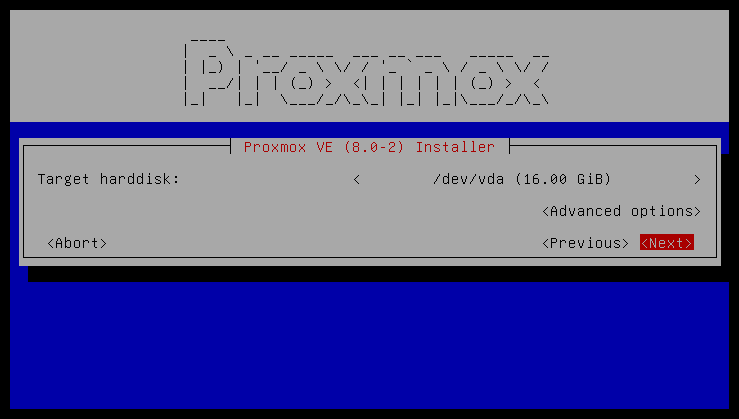
Both modes use the same code base for the actual installation process to benefit from more than a decade of bug fixes and ensure feature parity.
|
|
The Terminal UI option can be used in case the graphical installer does not work correctly, due to e.g. driver issues. See also adding the nomodeset kernel parameter. |
- Advanced Options: Install Proxmox VE (Graphical, Debug Mode)
-
Starts the installation in debug mode. A console will be opened at several installation steps. This helps to debug the situation if something goes wrong. To exit a debug console, press CTRL-D. This option can be used to boot a live system with all basic tools available. You can use it, for example, to repair a degraded ZFS rpool or fix the bootloader for an existing Proxmox VE setup.
- Advanced Options: Install Proxmox VE (Terminal UI, Debug Mode)
-
Same as the graphical debug mode, but preparing the system to run the terminal-based installer instead.
- Advanced Options: Install Proxmox VE (Serial Console Debug Mode)
-
Same the terminal-based debug mode, but additionally sets up the Linux kernel to use the (first) serial port of the machine for in- and output.
- Advanced Options: Install Proxmox VE (Automated)
-
Starts the installer in unattended mode, even if the ISO has not been appropriately prepared for an automated installation. This option can be used to gather hardware details or might be useful to debug an automated installation setup. See Unattended Installation for more information.
- Advanced Options: Rescue Boot
-
With this option you can boot an existing installation. It searches all attached hard disks. If it finds an existing installation, it boots directly into that disk using the Linux kernel from the ISO. This can be useful if there are problems with the bootloader (GRUB/systemd-boot) or the BIOS/UEFI is unable to read the boot block from the disk.
- Advanced Options: Test Memory (memtest86+)
-
Runs memtest86+. This is useful to check if the memory is functional and free of errors. Secure Boot must be turned off in the UEFI firmware setup utility to run this option.
You normally select Install Proxmox VE (Graphical) to start the installation.
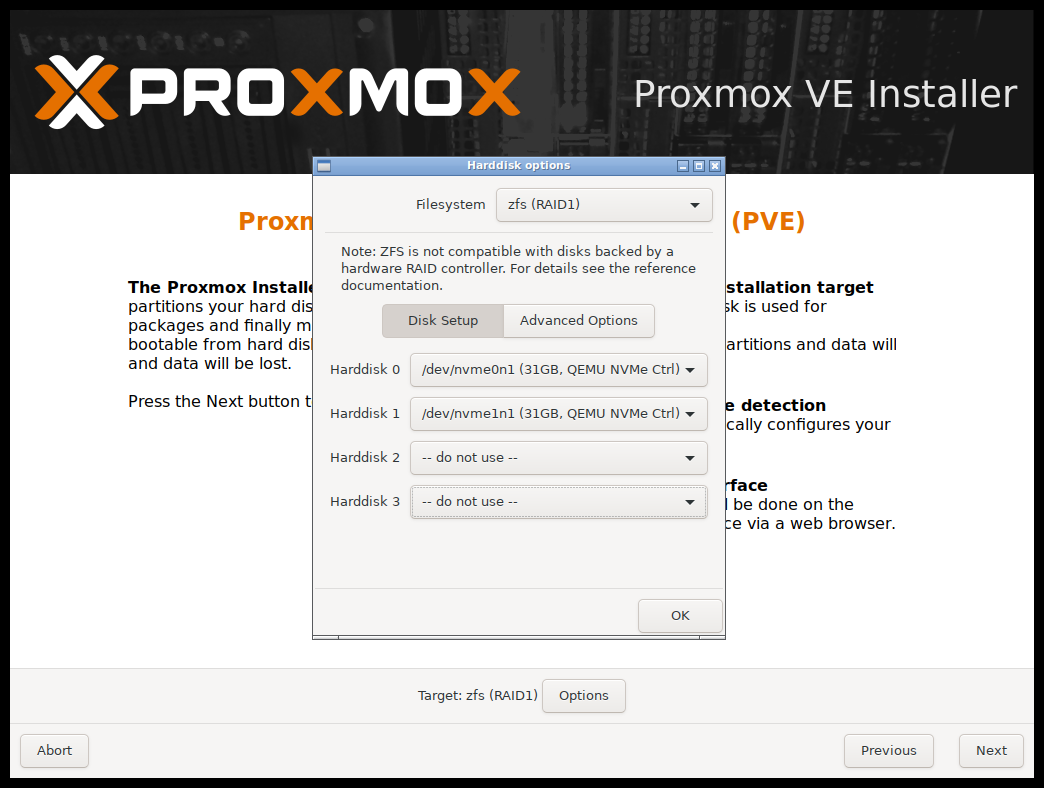
The first step is to read our EULA (End User License Agreement). Following this, you can select the target hard disk(s) for the installation.
|
|
By default, the whole server is used and all existing data is removed. Make sure there is no important data on the server before proceeding with the installation. |
The Options button lets you select the target file system, which defaults to ext4. The installer uses LVM if you select ext4 or xfs as a file system, and offers additional options to restrict LVM space (see below).
Proxmox VE can also be installed on ZFS. As ZFS offers several software RAID levels, this is an option for systems that don’t have a hardware RAID controller. The target disks must be selected in the Options dialog. More ZFS specific settings can be changed under Advanced Options.
|
|
ZFS on top of any hardware RAID is not supported and can result in data loss. |
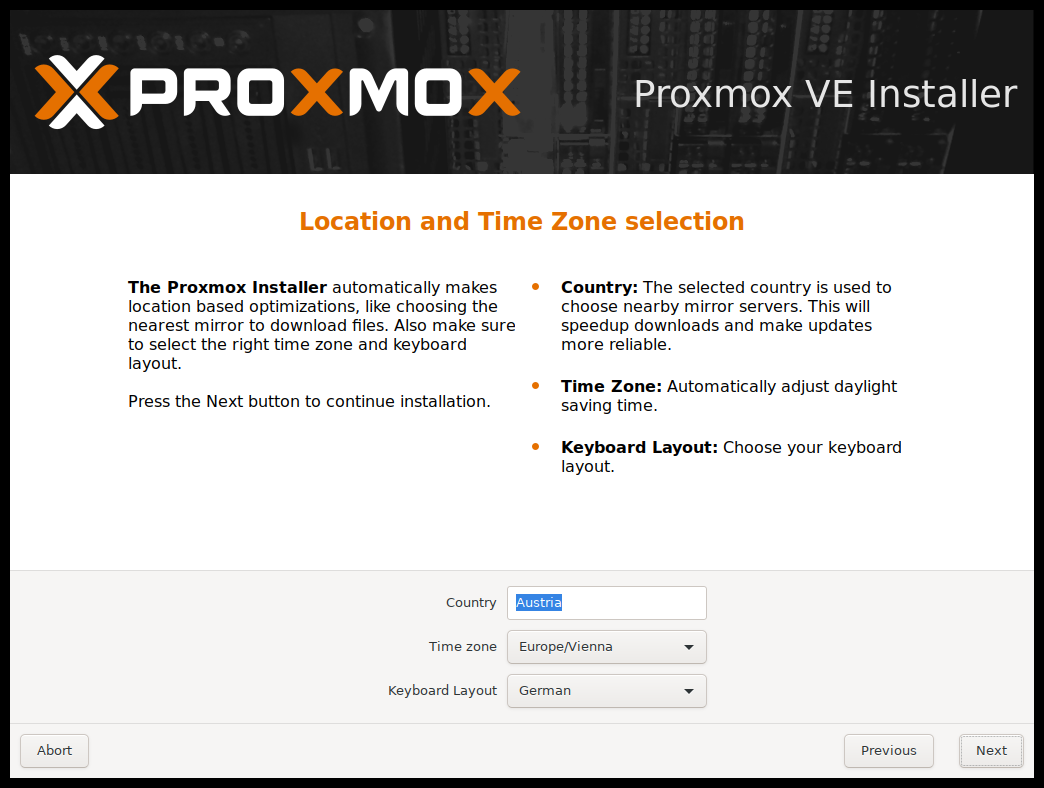
The next page asks for basic configuration options like your location, time zone, and keyboard layout. The location is used to select a nearby download server, in order to increase the speed of updates. The installer is usually able to auto-detect these settings, so you only need to change them in rare situations when auto-detection fails, or when you want to use a keyboard layout not commonly used in your country.
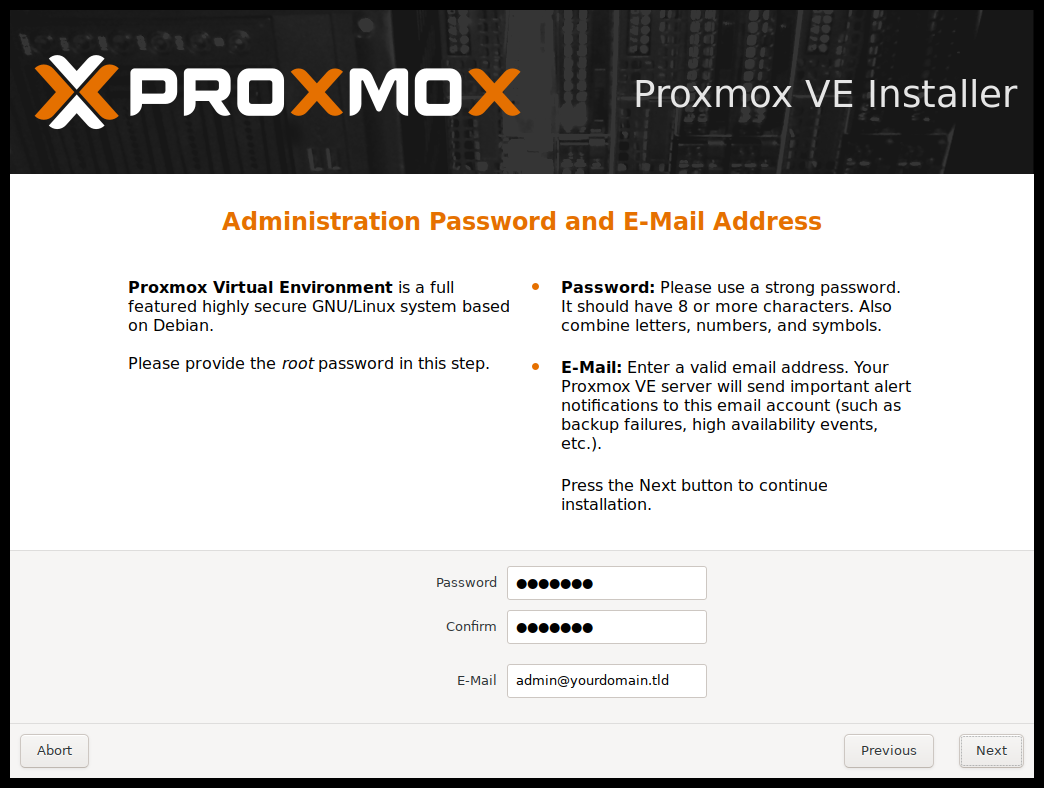
Next the password of the superuser (root) and an email address needs to be specified. The password must consist of at least 8 characters. It’s highly recommended to use a stronger password. Some guidelines are:
-
Use a minimum password length of at least 12 characters.
-
Include lowercase and uppercase alphabetic characters, numbers, and symbols.
-
Avoid character repetition, keyboard patterns, common dictionary words, letter or number sequences, usernames, relative or pet names, romantic links (current or past), and biographical information (for example ID numbers, ancestors' names or dates).
The email address is used to send notifications to the system administrator. For example:
-
Information about available package updates.
-
Error messages from periodic cron jobs.
The last step is the network configuration. Network interfaces that are UP show a filled circle in front of their name in the drop down menu. Please note that during installation you can either specify an IPv4 or IPv6 address, but not both. To configure a dual stack node, add additional IP addresses after the installation.
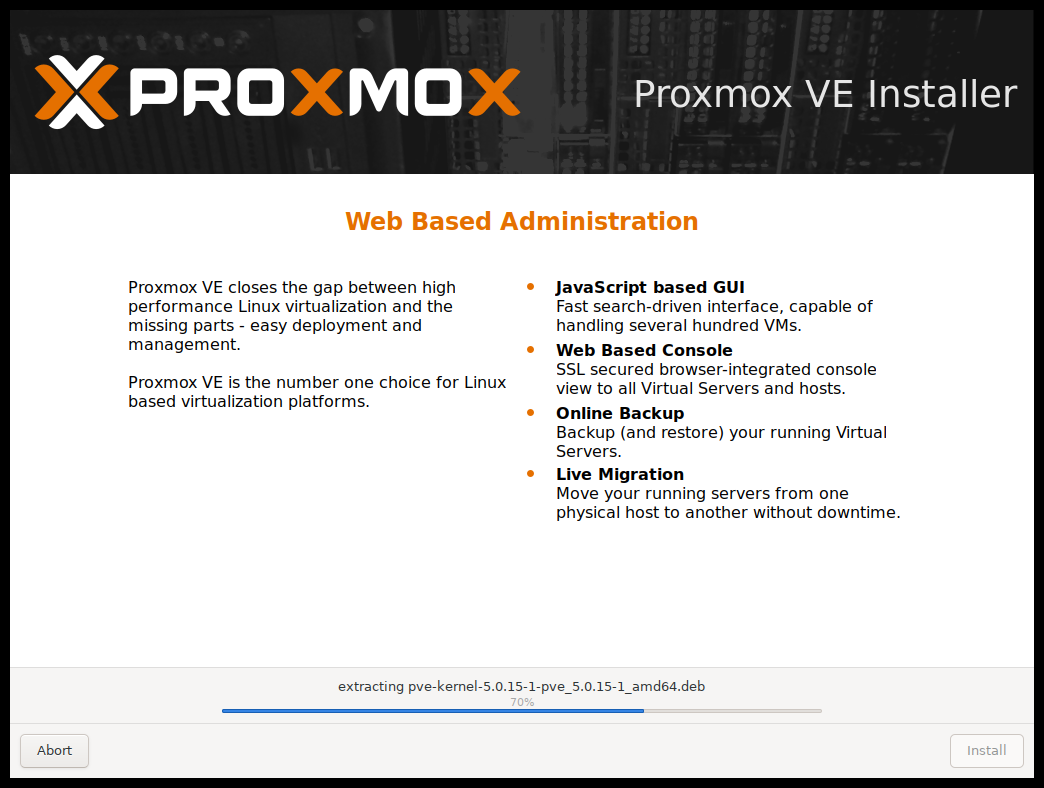
The next step shows a summary of the previously selected options. Please re-check every setting and use the Previous button if a setting needs to be changed.
After clicking Install, the installer will begin to format the disks and copy packages to the target disk(s). Please wait until this step has finished; then remove the installation medium and restart your system.
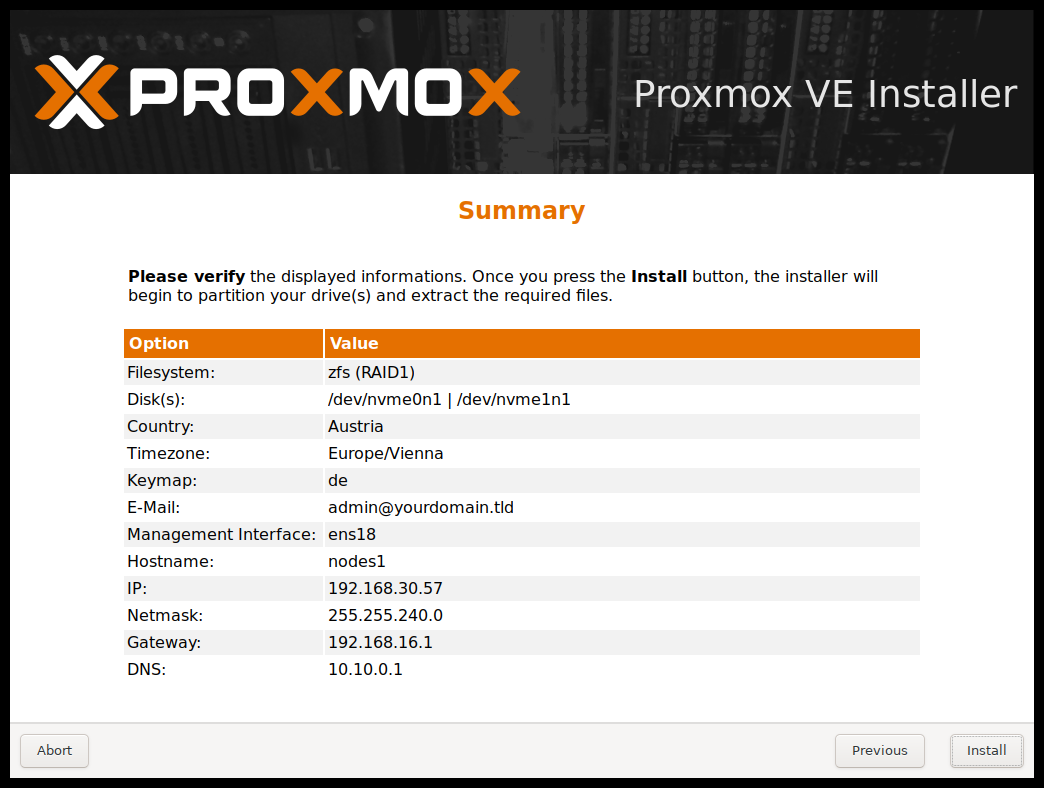
Copying the packages usually takes several minutes, mostly depending on the speed of the installation medium and the target disk performance.
When copying and setting up the packages has finished, you can reboot the server. This will be done automatically after a few seconds by default.
If the installation failed, check out specific errors on the second TTY (CTRL + ALT + F2) and ensure that the systems meets the minimum requirements.
If the installation is still not working, look at the how to get help chapter.
Accessing the Management Interface Post-Installation
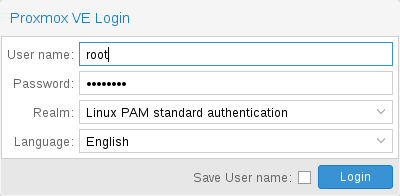
After a successful installation and reboot of the system you can use the Proxmox VE web interface for further configuration.
-
Point your browser to the IP address given during the installation and port 8006, for example: https://youripaddress:8006
-
Log in using the root (realm PAM) username and the password chosen during installation.
-
Upload your subscription key to gain access to the Enterprise repository. Otherwise, you will need to set up one of the public, less tested package repositories to get updates for security fixes, bug fixes, and new features.
-
Check the IP configuration and hostname.
-
Check the timezone.
-
Check your Firewall settings.
Advanced LVM Configuration Options
The installer creates a Volume Group (VG) called pve, and additional Logical Volumes (LVs) called root, data, and swap, if ext4 or xfs is used. To control the size of these volumes use:
- hdsize
-
Defines the total hard disk size to be used. This way you can reserve free space on the hard disk for further partitioning (for example for an additional PV and VG on the same hard disk that can be used for LVM storage).
- swapsize
-
Defines the size of the swap volume. The default is the size of the installed memory, minimum 4 GB and maximum 8 GB. The resulting value cannot be greater than one eight of the size of the hard drive (hdsize / 8).
If set to 0, no swap volume will be created. - maxroot
-
Defines the maximum size of the root volume, which stores the operation system. With more than 48 GiB storage available, the default is a quarter of the the size of the hard drive (hdsize / 4) with a maximum of 96 GiB. With less than 48 GiB of storage available, the root volume size is at least half the size of the hard drive (hdsize / 2).
- maxvz
-
Defines the maximum size of the data volume. The actual size of the data volume is:
datasize = hdsize - rootsize - swapsize - minfree
Where datasize cannot be bigger than maxvz.
In case of LVM thin, the data pool will only be created if datasize is bigger than 4GB. If set to 0, no data volume will be created and the storage configuration will be adapted accordingly. - minfree
-
Defines the amount of free space that should be left in the LVM volume group pve. With more than 128GB storage available, the default is 16GB, otherwise hdsize/8 will be used.
LVM requires free space in the VG for snapshot creation (not required for lvmthin snapshots).
Advanced ZFS Configuration Options
The installer creates the ZFS pool rpool, if ZFS is used. No swap space is created but you can reserve some unpartitioned space on the install disks for swap. You can also create a swap zvol after the installation, although this can lead to problems (see ZFS swap notes).
- ashift
-
Defines the ashift value for the created pool. The ashift needs to be set at least to the sector-size of the underlying disks (2 to the power of ashift is the sector-size), or any disk which might be put in the pool (for example the replacement of a defective disk).
- compress
-
Defines whether compression is enabled for rpool.
- checksum
-
Defines which checksumming algorithm should be used for rpool.
- copies
-
Defines the copies parameter for rpool. Check the zfs(8) manpage for the semantics, and why this does not replace redundancy on disk-level.
- ARC max size
-
Defines the maximum size the ARC can grow to and thus limits the amount of memory ZFS will use. See also the section on how to limit ZFS memory usage for more details.
- hdsize
-
Defines the total hard disk size to be used. This is useful to save free space on the hard disk(s) for further partitioning (for example to create a swap-partition). hdsize is only honored for bootable disks, that is only the first disk or mirror for RAID0, RAID1 or RAID10, and all disks in RAID-Z[123].
Advanced BTRFS Configuration Options
No swap space is created when BTRFS is used but you can reserve some unpartitioned space on the install disks for swap. You can either create a separate partition, BTRFS subvolume or a swapfile using the btrfs filesystem mkswapfile command.
- compress
-
Defines whether compression is enabled for the BTRFS subvolume. Different compression algorithms are supported: on (equivalent to zlib), zlib, lzo and zstd. Defaults to off.
- hdsize
-
Defines the total hard disk size to be used. This is useful to save free space on the hard disk(s) for further partitioning (for example, to create a swap partition).
ZFS Performance Tips
ZFS works best with a lot of memory. If you intend to use ZFS make sure to have enough RAM available for it. A good calculation is 4GB plus 1GB RAM for each TB RAW disk space.
ZFS can use a dedicated drive as write cache, called the ZFS Intent Log (ZIL). Use a fast drive (SSD) for it. It can be added after installation with the following command:
# zpool add <pool-name> log </dev/path_to_fast_ssd>
Adding the nomodeset Kernel Parameter
Problems may arise on very old or very new hardware due to graphics drivers. If the installation hangs during boot, you can try adding the nomodeset parameter. This prevents the Linux kernel from loading any graphics drivers and forces it to continue using the BIOS/UEFI-provided framebuffer.
On the Proxmox VE bootloader menu, navigate to Install Proxmox VE (Terminal UI) and press e to edit the entry. Using the arrow keys, navigate to the line starting with linux, move the cursor to the end of that line and add the parameter nomodeset, separated by a space from the pre-existing last parameter.
Then press Ctrl-X or F10 to boot the configuration.
Unattended Installation
The automated installation method allows installing Proxmox VE in an unattended manner. This enables you to fully automate the setup process on bare-metal. Once the installation is complete and the host has booted up, automation tools like Ansible can be used to further configure the installation.
The necessary options for the installer must be provided in an answer file. This file allows using filter rules to determine which disks and network cards should be used.
To use the automated installation, it is first necessary to choose a source from which the answer file is fetched from and then prepare an installation ISO with that choice.
Once the ISO is prepared, its initial boot menu will show a new boot entry named Automated Installation which gets automatically selected after a 10-second timeout.
Visit our wiki for more details and information on the unattended installation.
Install Proxmox VE on Debian
Proxmox VE ships as a set of Debian packages and can be installed on top of a standard Debian installation. After configuring the repositories you need to run the following commands:
# apt-get update # apt-get install proxmox-ve
Installing on top of an existing Debian installation looks easy, but it presumes that the base system has been installed correctly and that you know how you want to configure and use the local storage. You also need to configure the network manually.
In general, this is not trivial, especially when LVM or ZFS is used.
A detailed step by step how-to can be found on the wiki.
